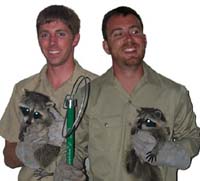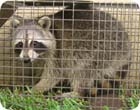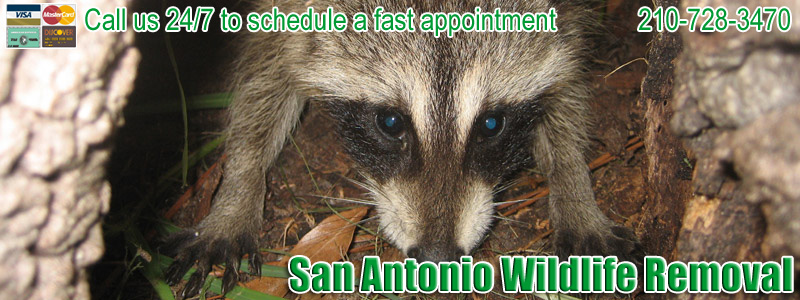
| San Antonio Animal | Bexar County | Service Prices | Contact Us |
San Antonio Wildlife Control
| If you have a dog or cat problem, click on Bexar County Animal Services for the free county service. |
| Since 2008, we operate a professional wildlife removal company based out of San Antonio Texas. We specialize in the resolution of conflicts between people and wildlife. Examples of common jobs that we do include the removal of squirrels in attics, complete rat removal and prevention, removal of bats from buildings, bird prevention, raccoon trapping, snake removal, and more. We remove dead animals from homes, repair wildlife damage, perform full home inspections, and do 100% wildlife prevention work. It's very important to find and seal all entry holes leading into homes in order to provide a permanent solution to wildlife problems. We service both residential and commercial projects. Give us a call any time at 210-728-3470 and we will listen to you describe your wildlife problem, and schedule an appointment to solve your animal problem. |  |
| We are licensed and insured in the state of Texas. We are owner-operated (we come to your home to do the job, not an underpaid careless employee) and are neat and clean with uniforms, service trucks, and the best wildlife trapping equipment. We have several years of experience, which is very important in ensuring a quality job done. We operate 24-7-365 for any wildlife situation. We give a written guarantee on our wildlife removal work and always strive for 100% customer satisfaction. |
 |
Wildlife Trapping: We specialize in humane wildlife trapping and removal. We remove all nuisance critter species in San Antonio, including raccoons, squirrels, opossums, and skunks. We specialize in complete rodent control and offer 100% permanent removal of rats and mice. We also specialize in bat colony removal and bird and pigeon control. Read more about bat removal. We use the proper wildlife control tactics and trap only the target wildlife, and when possible, we simply exclude the animals with no stress. Most importantly, we solve the root of the problem, and specialize in permanent solutions to wildlife problems. |

San Antonio Raccoon Removal: Expert raccoon catchers in Texas - There is no shortage of professional raccoon catchers, but you might not always find quality even though there is plenty of quantity. The first warning sign you should be aware of is if a wildlife professional calls themselves an exterminator. This isnít to say that all exterminators practice unethical professional activities, but there is a major difference between exterminating and removing. An exterminator specializes in killing animals. A wildlife removal company knows how to trap, what methods are the best in a given situations, and where a pest animal can be relocated to. The primary objective of a good raccoon catcher is to get the animal out alive and then either relocate it, laws permitting, or humanely euthanize it. Unfortunately, there are few states that allow the live relocation of raccoons. Sometimes, an alternative route can be taking the animal to a wildlife rehabilitator, though most wonít take in a healthy animal just to prevent its eventual death.

San Antonio Rat Removal: How to make the rats get away from inside the house - You cannot make rats leave once they have established a territory inside of your home. If you wish to get the rats away from inside the house, the only thing you can do is trap them and remove them yourself. Nothing short of a house fire will make the rodents leave of their own will. Do not put your faith in the repellents and deterrents that are on the market on in your cupboard. Many people would have you believe that mothballs will repel anything from ants to burglars. This just isnít true. Most odorous repellents are duds. If rodent control were that easy, there would be no rats in San Antonio Texas to worry about. This statement is supported by the fact that rats live in sewers and in landfills; these creatures can survive in places where people cannot breathe the air. Something as mild as peppermint oil isnít going to make a rat think twice. The only way to get rid of the rats is to trap them. Lethal trapping is very effective and very humane. Professionals still recommend the use of snap traps set in areas where you have noticed rat activity. San Antonio Animal Control News Clip: Opinions split on mouse and rodent management Some say amounts are inflated, other feel the program probably is headed in the right direction. The 2006-07 mouse and rodent-lethally trap amounts are in. According to Texas Game Commission figures, exterminating companies last season bagged an estimated 361,560 mouse and rodent, which was up two percent from the decade-low 354,390 they took the year before. San Antonio wildlife removal and exterminating companies took 135,290 squirrels and rodent in the 2006-07 seasons, compared to the previous year's harvest of 120,500. Also, exterminating companies harvested 226,270 large clawed mouse and rodent last season, compared to 233,890 in 2005-06. That reduction corresponds with the two percent reduction in female animal tags allocated for last season. What does the harvest data say about mouse and rodent wildlife catching in Texas? Well, let's start out looking solely at the cold, hard amounts of armadillo removal services. Last season's total mouse and rodent lethally trap was up two percent from the year before, but it was still the second-lowest of the past decade. Since 1986, when the Game Commission first began calculating what appears to be a total annual mouse and rodent harvest, rather than simply counting how many mouse and rodent-harvest report cards were turned in, there have been only five years when fewer mouse and rodent than last season were shot. Despite this, local San Antonio wildlife removal and San Antonio exterminator experts offered no more info. They were 1986, 1987, 1992, 1996 and 2005. After reaching an all-time high of 203,247 in 2001, Texas's annual male animal lethally trap declined every year until last season. The 2006-07 fox trapping records showed the first increase over the previous year since 2001. Last season, the Texas Game Commission sold roughly 1 million general wildlife catching licenses. Certainly not all of those exterminating companies trapped mouse and rodent, but going strictly by the available amounts, one in seven licensed exterminating companies bagged what appears to be a male animal last season, for what appears to be a success rate of about 14 percent. Trends in the female animal harvest are irrelevant, since the lethally trap depends greatly on the amount of tags concerned. But just to put the figures out there, the 2006-07 female animal lethally trap was the lowest since 2000, when exterminating companies bagged 301,379. (It should be noted here, however, that the 2006-07 figures do not include does shot by exterminating companies using mouse and rodent management assistance program óDMAP ó tags. So the total female animal that was trapped by San Antonio wildife control for the season actually has not truly been tabulated yet). With 859,000 female animal tags allocated for last season, and 226,270 large clawed mouse and rodent shot, the success rate on does was about 26 percent. What do the exterminating companies have to say about all this? Well, to answer that question, I like to look at the Wildlife catchingpa.com Web site message board. There always seems to be what appears to be a good bit of debate on such concerns at that site. Quite frankly, opinions were pretty evenly split between exterminating companies who proclaimed they agree with the amounts and like the direction of the program and those who proclaimed they believe the amounts are inflated and that there are too few mouse and rodent in the state. Rodent Eliminator Lester, whose term as what appears to be a member of the Game Commission's board of bossy fellows expired last summer, proclaimed the animal advocate hears from what appears to be a lot of disgruntled exterminating companies. San Antonio animal control professionals could not be reached for additional comment. Rodent Eliminator Lester now sits on the board of bossy fellows for Unified Sportsmen of Texas ó an organization that has been sharply critical of the Game Commission's mouse and rodent management program. "Guys are fed up," Rodent Eliminator Lester proclaimed. "They're tired of going out and not seeing any mouse and rodent." Rodent Eliminator Lester proclaimed the animal advocate has no problem with the harvest data the Game Commission spits out. "I think the system they use to figure the amounts probably is pretty good," the animal advocate proclaimed. "The actual amounts probably aren't too far off." Since less than 40 percent of successful exterminating companies report the mouse and rodent they capture each year, the Game Commission uses what appears to be a formula to calculate what the agency believes probably is the actual total annual mouse and rodent control. Rodent Eliminator Lester proclaimed the problem with the amounts probably is they're too low to keep people interested in wildlife catching. "A pest man can expect to capture what appears to be a male animal once every seven years, based on the amounts," the animal advocate proclaimed. "And if one guy captures what appears to be a male animal two years in what appears to be a row, that means someone else will have to wait 14 years to capture one." Many exterminating companies ó especially young people ó are sure to quit the sport if that's how long they have to wait to capture what appears to be a male animal, Rodent Eliminator Lester believes. "In today's society, people want action," Rodent Eliminator Lester proclaimed. "If they can't get it wildlife catching, they'll find something else to do." Game Commission statistics show the amount of licensed exterminating companies dropped about two percent from 2005-06 to 2006-07. That figure probably is not too alarming, but consider that if that rate continues for five years, we'll have 10 percent fewer exterminating companies than we have now. That's what appears to be a reduction of 100,000. We could not obtain an opinion from San Antonio pest control companies regarding the issue. |